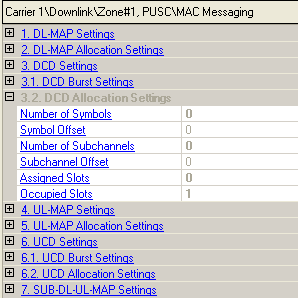

When Auto Allocation is on in the zone editing window, an algorithm configures the bursts automatically based on the number of occupied slots and maximum number of subchannels available in the zone, avoiding any burst overlap where possible. If Auto Allocation is off, you can manually position and allocate the data region by editing the number of symbols, subchannels, and their respective offsets.
You can view the automatic or manual  burst allocation
configurations in the zone
plot view. Any bursts that overlap, exceed the number of assigned
slots, or are too small are shown in red. Click Status
Windowin the tool bar for suggestions to resolve any conflicts.
burst allocation
configurations in the zone
plot view. Any bursts that overlap, exceed the number of assigned
slots, or are too small are shown in red. Click Status
Windowin the tool bar for suggestions to resolve any conflicts.
In version 1.9.0.1 or earlier, the N7615A/B included the DCD as part of the DL-MAP message when present. In this version, DCD is now a separate burst from the DL-MAP, following the DL-MAP and UL-MAP if present.
If you save a settings file using the 1.9.0.1 or earlier version with DL-MAP, UL-MAP, DCD and UCD all turned on, and the Auto Allocation turned Off, when you import this settings file using this version, there will be a warning message, "DCD or UCD is out of range". This is due to the different allocation schemes. To solve this problem, just increase the Number of Symbols of the PUSC zone and properly allocate the DCD and UCD.
If Auto Allocation is off in the zone editing window, use this cell to select the number of symbols to be used for the burst.
For DL PUSC, the value must be an even number because DL PUSC is divided into slots of 2 symbols x 1 subchannel (section 8.4.3.1 in 802.16-2004/Cor/D3).
For DL FUSC, slots are 1 symbol x 1 subchannel so the selected value is limited only by the bandwidth, frame length, downlink ratio, and other associated symbol parameters set in the OFDMA specific parameter section of the Waveform Setup window.
For DL AMC, the value must be a multiple of 3 because DL AMC is divided into slots of 3 symbols by 1 subchannel.
If Auto Allocation is off in the zone editing window, use this cell to manually position the burst on the horizontal axis (x), if necessary, to avoid any burst overlap.
If Auto Allocation is off in the zone editing window, use this cell to select the number of subchannels to be used for the burst.
If Auto Allocation is off in the zone editing window, use this cell to manually position the burst on the vertical axis (y), if necessary, to avoid any burst overlap.
Displays the total available  slots
in this burst based on the number of symbols times the number of subchannels
selected.
slots
in this burst based on the number of symbols times the number of subchannels
selected.
Displays how many  slots
are needed for the burst based on the total length in bytes of all MAC
PDUs. It also depends on the rate ID and coding type selected for each
burst.
slots
are needed for the burst based on the total length in bytes of all MAC
PDUs. It also depends on the rate ID and coding type selected for each
burst.